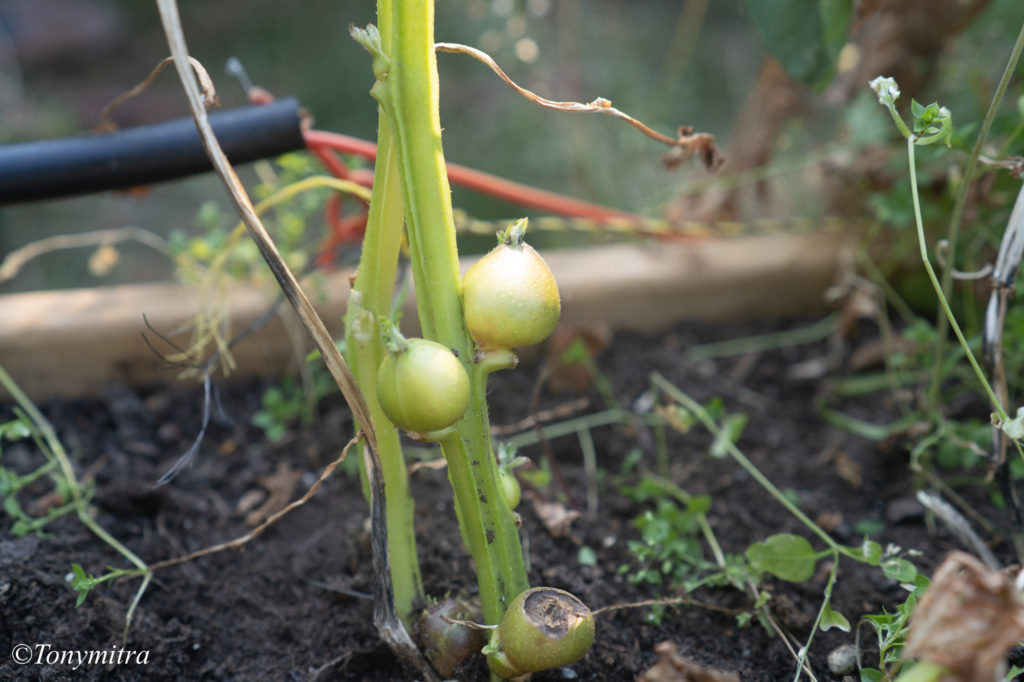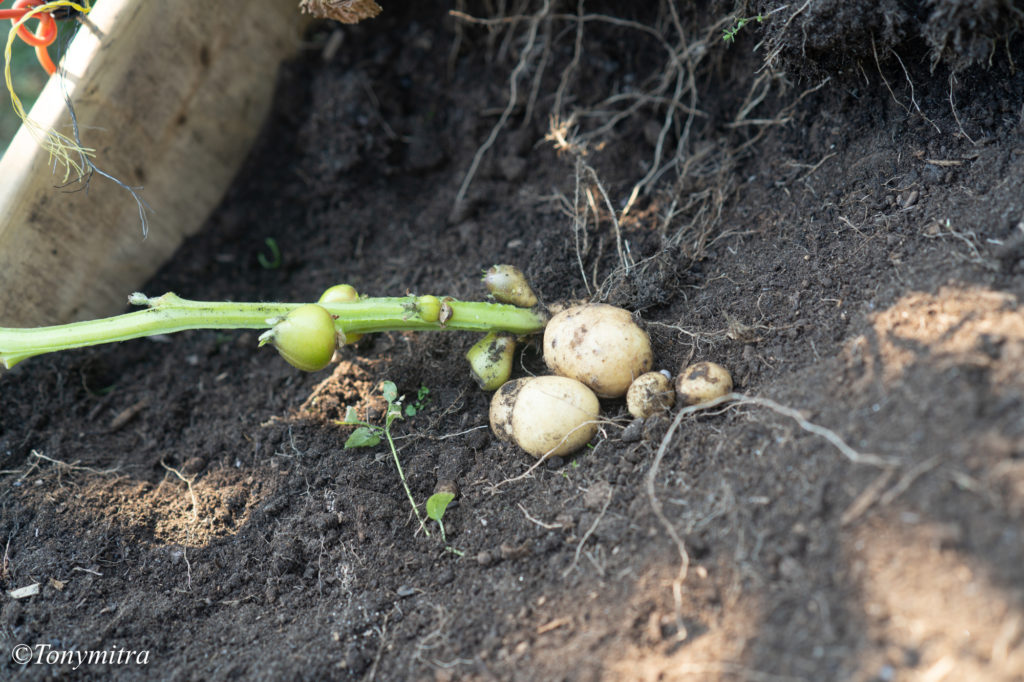I have been growing potato for a while now. However, this year I noticed something different in some of my crop. For one thing, many more of the plants produced potato berries, or seed pods, than before. But that was not all.
One potato plant had a most peculiar development. IT was producing potatoes above ground, one at every segment where new leaves or a new branch come out. There, at the juncture, a fat round thing grew, almost like a tumour or something. A closer look proved it to be a sort of a potato, growing above ground and off the stalk itself. As it a tuber is being turned Ito a fruit.

Well, one could not call this a fruit since a fruit is to be the container for seed. This guy was not involved in producing seed pods. Rather, it was producing potatoes, but above ground. I had plucked a few larger ones and taken a good look at them. They showed faint signs of turning greenish on the skin – a trait that normal potato have, if they are exposed to the sun. This is the potato way to prevent animals trying to eat the exposed potato, but turning toxic. A half exposed potato will turn green on the exposed section, and remain normal for the bottom half.
Also, at the top end of this thing, there were clear signs of new leaves sprouting. It was, indeed, trying to create a plant, just like a normal potato. Unlike a normal potato, it did not have roots in the ground, taking nourishment. It was taking it directly from the plant itself, through its attachment with the stalk. I did see, however, some tiny thread like extensions from the bottom, a millimetre or two in length. I wondered if those were left over traits of the normal potato, seeing down roots, looking for soil.
A few of these were already attacked by some insect and the top section partially chewed off, the best I could tell.
I wondered if this is how evolution works and if I was seeing an example of it. This is a variant of the normal potato. Somehow it came to existence. We know five kids of the same parents will not be clones but will have variations, some of which will be different from either parent or any of its ancestor. This variant trait, if proven to have some clear advantage, then in natural circumstance that offspring would do better than others and might end up producing more kids with this trait. Eventually, if circumstance remains favourable, this trait might become one of the dominant features of a new group of plants that are substantially different from its ancestors. This variant is now on the way to become a new species.
Natural selection aside, this can also happen through personal involvement of a group of creatures, such as animals that prefer a certain trait in themselves or in other plants or animals it supports and nurtures. Humans themselves have managed to bring forward plants very different today, from the earlier versions they favoured and tended for over the millennia. This involves plants as well as animals that are now domesticated and a far cry from their original wild version.
I was clearing out this bed, to prepare it for fall planting of other tubers – beet, turnip and perhaps carrots. So I was uprooting and harvesting the potato. About this particular plant, I had already pulled off a few of the above ground potato attached to it, taken a look and buried them back in the soil. I have a habit of burying back organic matter that I grew but do not consume. The plants themselves are usually crushed, balled up and reburied in the same soil. It came from nutrients off the ground, and goes back in the ground, to be composted back by micro organisms – the natural recycling that the living plant is so good at.
Thus, I pulled this plant off too and reburied it, but I remembered at the last moment to take a few pictures to preserve the occasion. I checked if it had also produced tubers underground and if so, how many. Apparently it did produce underground regular tubes too, but not too many. So it was a halfway transient variant, able to produce tubers both underground and above ground, but not too many nor too large anywhere.

It came upon me to write about it the next day. To me, this is evolution at work. This is what mutation, natural variation and random change means – as observed by early stalwarts like Charles Darwin in vast varieties of living creatures and how Gregor Mendel figured out how heredity works in green pea. If this trait in the potato, of growing tubers above ground, is to be considered an advantage, then humans could replant the produce of this plant again and again, selectively filtering out those that produced more tubers underground, and filtering in those that grew more above ground. Eventually, it might lead to potatoes that only grew above ground, and, hopefully, were good to eat too – a novelty.
I was not involved in trying to create any specific hybrids. Not in this late stage of my life, as a home gardener trying to produce my own food.
But I am an observer – with a habit of analysing what I see around me, and make sense of it. And thus, I decided to jot down my observation, while having today’s morning coffee.

thought of including Darwin’s image in the same blog. After all, I did find something of him in my own backyard garden, even if I am completely unaware of him ever finding evidence of any evolutionary change of this kind in potato.
If you wish to comment, please feel free to use the comment box below. Thank you for reading this note.
